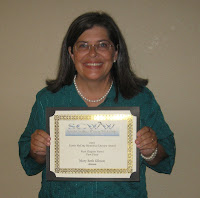 Meeting authors, chatting with agents and editors, winning an award—all in
Myrtle Beach! And the weather was exquisite. For writers, it was Nirvana. Last
weekend I attended the 2012 South Carolina Writer’s Workshop Conference at the
Hilton resort and I couldn’t have had a better time.
Meeting authors, chatting with agents and editors, winning an award—all in
Myrtle Beach! And the weather was exquisite. For writers, it was Nirvana. Last
weekend I attended the 2012 South Carolina Writer’s Workshop Conference at the
Hilton resort and I couldn’t have had a better time.
Friday night, my husband, Wendy, and I attended an outdoor
reception where fellow Aiken critique group member, Steve Gordy, introduced me
to published authors, agents, and best-selling writers of the future. Being
naturally shy, this was a blessing. It is incredibly uplifting to speak with
people who all share the same passion.
 Soon we filed into the banquet where I was awarded first
place in the Novel First Chapter category of the Carrie McCray Memorial
Literary Award. I am humbled by and proud of this honor. This year, they included
the winning pieces from all categories in the annual anthology, The Petigru Review. It was a thrill to
see my writing in print.
Soon we filed into the banquet where I was awarded first
place in the Novel First Chapter category of the Carrie McCray Memorial
Literary Award. I am humbled by and proud of this honor. This year, they included
the winning pieces from all categories in the annual anthology, The Petigru Review. It was a thrill to
see my writing in print.
I was also excited to meet one of the judges of the
competition, Barbara Claypole-White, an enthusiastic writer who offered me a
tremendous amount of encouragement. Her book, An Unfinished Garden, just came out in August and is wonderful. Watch
this blog for my review.
Each time I go to a conference, I like to “stretch” myself
and this time I chose to make a pitch for my book to an editor. The conference
scheduled a slot for me for ten dollars, a bargain for such an opportunity.  To pitch, you’re expected to excite an industry professional
with your book idea in a one- or two-sentence summary, hopefully delivered from
memory. I was a nervous wreck. Wendy drilled me throughout the four-hour drive
to Myrtle Beach and at random times after we arrived.
To pitch, you’re expected to excite an industry professional
with your book idea in a one- or two-sentence summary, hopefully delivered from
memory. I was a nervous wreck. Wendy drilled me throughout the four-hour drive
to Myrtle Beach and at random times after we arrived.
Finally my 2:15 appointment arrived. After a minimal amount
of small talk (too nervous), I blurted my spiel, hopefully not too fast.
Nothing actually came of it, but I DID IT. Later that night, Wendy and I
celebrated with a bottle of Asti Spumanti.
I am greatly encouraged by two agents who invited me to send
them my book for their consideration. It’s not quite ready, but I am pounding
the keys. A door has opened and I’m determined to walk right through.
Shameless plug: Search Amazon.com for The Petigru Review Volume 6 or click here to order a copy for $9.99.
NOTE: If you're a writer from South Carolina, look into the SCWW. This organization has schooled me, guided me, and encouraged me. www.myscww.org





